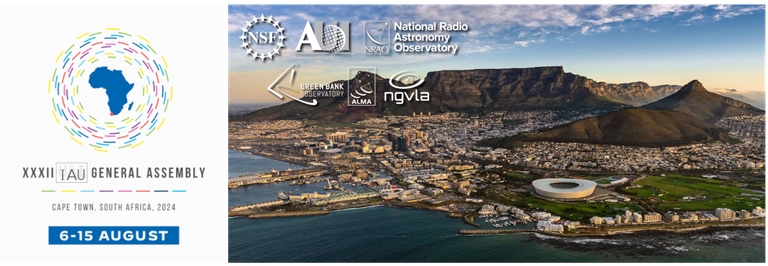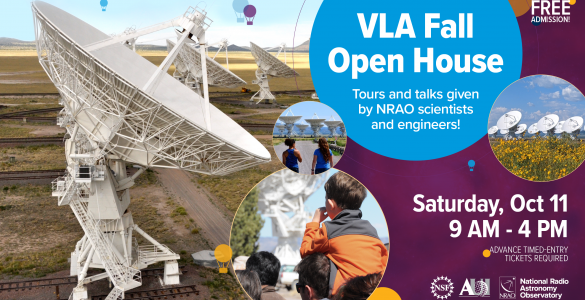The International Astronomy Union (IAU) is General Assembly XXXII in Cape Town, South Africa, August 6 – 15, 2024. This event is one of the world’s largest international gatherings of astronomers, and the U.S. National Science Foundation National Radio Astronomy Observatory (NSF NRAO) and the Green Bank Observatory (NSF GBO) will share their latest science and resources through presentations and exhibits.
Stop by the NSF NRAO booth in the exhibit hall to learn about the latest science, research opportunities, student programs, and resources like the proposed next generation Very Large Array (ngVLA), the Green Bank Telescope (NSF GBT), the Very Large Array (NSF VLA), the Very Large Baseline Array (NSF VLBA), the Atacama Large Millimeter/submillimeter Array (ALMA) and ALMA’s Wideband Sensitivity Upgrade (WSU).

NSF NRAO/GBO and their administrator, Associated Universities, Inc., along with science users from the community, will participate in the following Division events, symposia, working groups, and focus meetings:
- A Coherent View of Atomic and Molecular Gas from Infrared to Radio Wavelengths, Focus Meeting 2
- The Future of Radio Astronomy in an Increasingly Crowded Spectrum, Focus Meeting 5
- IAU 389: Gravitational Wave Astrophysics
- Division B: Facilities, Technologies, and Data Science
- Division C: Education, Outreach, and Heritage
- Division H: Interstellar Matter and the Local Universe
- Division J: Galaxies and Cosmology
- IAU 392: Neutral Hydrogen in and Around Galaxies
- Astronomy for Equity and Inclusion, Working Group 4
- New Horizons at the Interface between Computational Astrophysics and Big Data
- Multi-Wavelength Astronomy, Focus Meeting 11
- Dark and Quiet Sky Protection, Working Group 6
The research presented is built upon data gathered by the NSF NRAO/GBO instruments, as well as the research projects ASTRO ACCEL, ACEAP, CHILES, NANOGrav, PHANGS, and VLASS.
On Tuesday August 6, Dr. Devaky Kunneriath will discuss “Star formation and molecular gas observations of NGC 5331 with VLA and ALMA” in the morning (FM2). At the same session, Dr. Will Armentrout will present on “Star formation efficiency on the outer edge of the Milky Way” (FM2). In the afternoon, Dr. Cosima Eibensteiner will talk about “PHANGS-MeerKAT and MHONGOOSE HI observations of nearby spiral galaxies: physical drivers of the molecular gas fraction” (FM2). During the Astronomy Outreach Institutional Meeting, AUI Education and Public Outreach Coordinator María Fernanda Durán will share a presenation and poster about “Astro Expeditions Chile: astronomy off the beaten path”.
Wednesday, August 7, is a busy day, when Dr. David Rebolledo looks at “A resolved view of the impact of massive star formation in the atomic, molecular and ionized gas in the Carina Nebula” in the morning (FM2), while Dr. Loreto Barcos-Muñoz explores “Star Formation and Feedback in Local Luminous and Ultra Luminous Infrared Galaxies” (FM2). Later in the day Dr. Kimberly Emig talks about “Cold ‘dark’ gas in Cygnus X: The first large-scale mapping of low-frequency carbon recombination lines” (FM2), while Dr. Tony Beasley discusses “Developments in NRAO-SpaceX Operational Data Sharing (ODS): Exploring Spectrum Coexistence with Satellite Operators” (FM5). Meanwhile Tiffany Stone Wolbrecht will discuss “ACEAP – The Chile Expedition for Astronomy Educators and Outreach Professionals” (Astro Education), while Giorgio Siringo and Sean Dougherty will present about “Spectrum Management at ALMA” (CPS-2).
On Thursday August 8, Dr. Srikrishna Sekhar will talk about “GRIDFlag : RFI flagging in the UV domain” (FM5 & FM7). Then on Friday, August 9, Yasmin Catricheo will discuss “Cosmovisions of the Pacific” (Div C), while Dr. L. Viktor Toth will talk about “The ngVLA as a Gamechanger” (Div H). Later that day Dr. Brian Kent will look at “3D Astronomical Visualization with Open Shading Language” (Div B), Tiffany Stone Wolbrecht will explore “ASTRO ACCEL for Advancing Astronomy Education” (Div C), and Dr. Scott Ransom will look at “The Future of NANOGrav and the DSA-2000” (IAU 389).
On the following Monday August 12, Dr. Mark Lacy will present on “The VLA Sky Survey” (Div J 2.1), Dr. Samantha Scibelli will discuss “Complex Chemistry at the Earliest Stage of Low-mass Star Formation” (Div H), Dr. Phil Jewell will go over “The Future of ALMA: Wideband Sensitivity Upgrade and Next-Generation Concepts” (Div B) and Drs. Tony Beasley and Phil Diamond will look at the “Synergies between ngVLA and SKA-Mid” (Div B).
On Wednesday, August 14, NSF NRAO and AUI ALMA Outreach and Diversity Officer, Dr. Sonia Duffau, will share a presentation as part of the IAU Women in Astronomy Working Group Session on the PROVOCA mentorship program, based in Chile.
Finally on Thursday August 15, Yasmin Catricheo will explore “Astronomy Accessible Software for All (AASA)” (WG4) and Dr. Julia Blue Bird will discuss “High Redshift HI & H2 With CHILES” (IAU 392). In the afternoon Drs. Giorgio Siringo and Sean Dougherty will look at “Radio Frequency Interference at the ALMA Observatory” (WG6), Dr. Lucas Hunt will discuss “The VLBA New Digital Architecture: A New Digital Backend for the VLBA” (FM11), Dr. Megan Johnson will explore “ngVLA for VLBI in the 2030’s and Beyond” (FM11) and Dr. Danielle Rowland will look at “Diversifying STEM: Collaborative Initiatives at NRAO” (WG4).
NSF NRAO News and Public Information Officer, Corrina Jaramillo Feldman, is one of a handful of U.S. volunteers to support education and public outreach at the IAU meeting. Felman created a variety of content to promote and share IAU resources for students and schools internationally, along with virtual education sessions with astronomers, including over 15 topics such as spectroscopy, the history of astronomy, stars and stellar physics, and more. This resulted in engagement from 32 schools across 10 countries. Feldman will also share STEAM Ed activities with school visits, such as a virtual reality program of molecular clouds, a lesson using merge cubes, and various lessons using hands-on laser mazes. Finally, Feldman will act as a photographer and content cultivator throughout the conference, and post to the IAU General Assembly 2024 Facebook page.

The NSF NRAO Office of Diversity and Inclusion is honored to note that the The Central American Caribbean Bridge in Astrophysics (Cenca Bridge) program has won an IAU 2024 ODE Development Prize. NRAO was proud to support the team, co-led by Antonio Porras Valverde, Gloria Fonseca Alvarez, Valeria Hurtado, and Yahira Mendoza Moncada, in their award application. CENCA Bridge has created an astronomy research and education platform to share opportunities with aspiring astrophysicists across Central America and the Caribbean.
Follow the NSF NRAO (FB, X, LinkedIn, Instagram) and NSF GBO (FB, X, LinkedIn, Instagram) to learn about the latest events happening at the conference.
About NSF NRAO/GBO
The National Radio Astronomy Observatory and the Green Bank Observatory are major facilities of the National Science Foundation, operated under a cooperative agreement by Associated Universities, Inc.
NRAO Media Contacts
Jill Malusky
News and Public Information Manager, NRAO/GBO
Tel: +1 304-456-2236
jmalusky@nrao.edu
Corrina C. Jaramillo Feldman
Public Information Officer, ngVLA
Tel: +1 575-842-9366
cfeldman@nrao.edu











